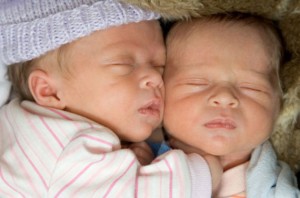 When the uterus contains more than one baby, it is referred to as “multiple pregnancy” or “multiple gestation”. Most multiple pregnancies consist of twins, although triplets and even quadruplets are becoming more frequent due to medical advances in fertility. Twins occur naturally in about one in 100 pregnancies, triplets occur in about 1 in 8,000 and quadruplets occur once in every 500,000 pregnancies. The chances of having multiple pregnancy increase if your mother had fraternal (non-identical) twins. The chances of becoming pregnant with more than one baby increases until about age forty. After age forty, your chances go down.
When the uterus contains more than one baby, it is referred to as “multiple pregnancy” or “multiple gestation”. Most multiple pregnancies consist of twins, although triplets and even quadruplets are becoming more frequent due to medical advances in fertility. Twins occur naturally in about one in 100 pregnancies, triplets occur in about 1 in 8,000 and quadruplets occur once in every 500,000 pregnancies. The chances of having multiple pregnancy increase if your mother had fraternal (non-identical) twins. The chances of becoming pregnant with more than one baby increases until about age forty. After age forty, your chances go down.
Today, most multiple pregnancies are diagnosed with an ultrasound exam. Diagnosis is usually early in the pregnancy, which allows both you and your healthcare provider to prepare for multiple births. It also give your family time to prepare for having more than one baby. Besides buying two cribs and two car seats, you will also need time to adjust emotionally.
You don’t actually have to have two of everything. Having a single swing or single bouncer is fine because you can give them turns or use it while the other child is being fed or burped.
Help with twins is available
You may find that talking to other parents of multiples to be helpful in planning. There are may special resources and support groups available for parents of multiples. The following is a list of support groups.
NOMOTC (National Organization The Triplet Connection
of Mothers of Twins Clubs, Inc.)
http://www.nomotc.org/
NOMOTC EXECUTIVE OFFICE
2000 Mallory Lane
Suite 130-600
Franklin, TN 37067-8231
248-231-4480
[email protected]
Twins World
http://www.twinsworld.com/twinorgs.shtml
Planning for Multiples
These are some things you and your partner can do while planning for
multiples:
~ Consider using a diaper service – it may be cheaper than disposable diapers. Ask for a multiples discount!
~ Relax your standards for a clean house. Be realistic about what you can accomplish each day
~ Unplug the phone while you and your babies are napping.
~ Don’t neglect your personal need for rest, relaxation, and good nutrition.
~ Make a “date” with your partner and keep it.
~ Ask your parents, other family members, or friends for support.
~ Give serious consideration to breastfeeding. It is more nutritious for your babies, more convenient, and saves the cost of formula.
How Family and Friends Can Help You With Multiples
~ Give practical gifts, like baby clothes or equipment. A rocking chair, video camera, or cordless phone are the ultimate gifts for a family with multiples.
~ Give a few weeks or months of diaper service.
~ Bring nutritious snacks or food, such as a fruit, a casserole or a whole meal. New mothers are often too busy to take time to eat as they should.
~ Help clean house.
~ Offer to go grocery shopping and take the babies with you.
~ Invite other siblings out for treats.
~ Organize the neighborhood to cook a meal each day for the first month. Give the parents a menu calendar so they know what to expect each day.
~ Offer to bathe, feed, and baby-sit the babies.
~ When the babies are older, invite one or more to stay overnight, give the parents a weekend alone. 10. Give the new mother a gift certificate for a
massage, facial, exercise program, or swimming pool membership.
The Truth About Twins
~ The incidence of fraternal twinning is affected by heredity, race, material age and the number of children a woman has previously had.
~ The odds of having two sets of identical twins are at least one in 70,000.
~ Women between 35 and 39 years old have a tenfold increase in chance of having twins over teenagers.
~ Fraternal twins occur as a result of several eggs being released by the mother at the same time, an event controlled by her level of follicle stimulating
hormone.
~ Female fraternal twins have an increased chance, or have fraternal twins, at an actual rate of about one in 6o births or more.
~ Male fraternal twins do not have increased chances for fathering twins.
~ Sisters of fraternal twins tend to produce twins at a higher rate than singletons or sisters of identical twins. Brothers of fraternal twins do not
have this tendency, although their daughters may.
~ Daughters of female and male fraternal twins are more apt to have twins; this is not necessarily true for sons of female and male fraternal twins.
~ Because the daughters of male fraternal twins are more likely to have twins, it appears that twins “skip” a generation, but this is not necessarily the case.
~ Once a woman has had fraternal twins, her chance of having another set is four times that of the general population.
~ The odds of having two sets of fraternal twins is about one in 3,000.
Recommended Reading
All About Twins
Dr. Gillian Leigh, 1983, 252 pages.
Care of Twin Children: A Common Sense Guide for Parents
Rosemary Theroux, RN and Josephine Tingley, RN, 1984, 208 pages.
Having Twins
Elizabeth Noble, 1991, 386 pages.
The Joy of Twins
Pamela Patrick Novotny, 1988, 294 pages.
The Parents’ Guide to Raising Twins
Elizabeth Friedrich and Cherry Rowland, 1983, 304 pages.
We Are Twins, But Who Am I?
Betty Jean Case, 1991, 203 pages.